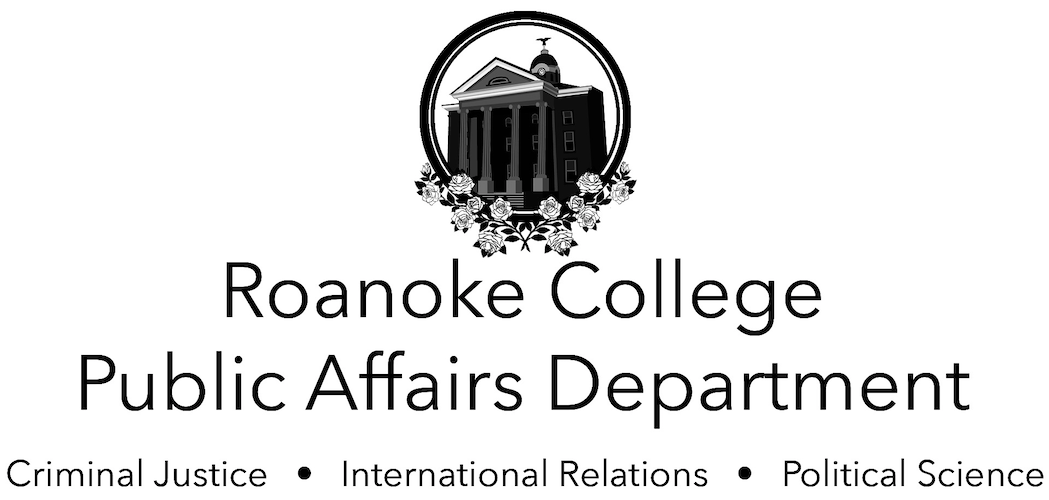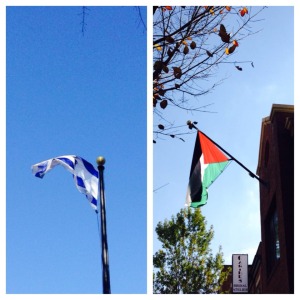On November 14th, Dr. Willingham’s Modern Middle East class here at Roanoke College departed at 4:00 AM for Washington, D.C. to visit the Palestinian and Israeli embassies. The purpose of this trip was to give the students a taste of the ‘real’ politics of the two parties, as well as to help them understand the deep complexities of the conflict. As of November 14th, the class had learned the history of the conflict up until the 1973 war. They had just begun discussing the negotiations when it came time for the trip.
After 4 dark hours, the class finally reached D.C. There was tangible tension in the crisp air as they advanced toward the Israeli embassy first. Rounding a corner, it loomed into view and beckoned them to its gates. A security officer emerged and informed the students that they must leave their purses/bags in a car outside the embassy. Then, they lined up outside and waited to go through security. Finally, another officer came out and requested that the students go through two at a time. Mathilda Nassar and Shaina Lidd took the initiative and handed the officer their IDs. After a few moments of deliberation in Hebrew, in which Mathilda’s passport was examined in detail, the officer stated that now the students would go in one at a time.
Mathilda, an American citizen born in the West Bank, was taken in first, alone. She remembers her fellow classmates’ puzzled faces as the door closed. Aside from the regular security check that most people go through (taking off jackets and shoes and walking through the detector), Mathilda had extra security checks performed on her. In the corner of the room, there was a small space where a curtain could be drawn. She was led there and told to wait further instruction. At last, a woman security officer approached her and told her she needed to be checked. Mathilda was searched twice, thoroughly, first by hand then by a gadget of some kind. After another few minutes of deliberation, she was told she could go. Her classmates came in two at a time with only minimal security checks.
An Israeli delegate spoke to the class about various issues that Israel faces, but failed to elaborate on the relations with the Palestinians, which was the main reason for the class trip. When students asked the delegate questions pertaining to the Palestinians, he answered vaguely and without much detail. However, it was informative in the sense that the class could see the Israeli government’s position on issues such as ISIS, Iran, and the like. The ambiguity surrounding the Palestinian issue showed the students just how sensitive the subject is.
The visit to the Palestinian embassy stood out in stark contrast. Located on a bustling street in Georgetown and crammed between a Chinese restaurant and “For Sale” Retail Place, the embassy was hardly noteworthy. The only characteristic that gave it away was the raised Palestinian flag flapping in the breeze. The class, led by Mathilda who had interned at the embassy last fall as part of the Washington Semester, rang the doorbell and were buzzed in. They walked up the stairs and were greeted promptly by the general consulate, who ushered them downstairs into the Ambassador’s conference room. The long table was set with bottles of water, cookies, and an information packet on the Palestinian side of the conflict.
The Ambassador, Maen Rashid Areikat, who represents the PLO, sat down at the head of the table and introduced himself. He spoke mostly about the history of the conflict with Israel, starting with 1948. He articulated the Palestinian position well, and ended by warning of the danger of associating radical Islamist movements with the Palestinian people as a whole. He asserted multiple times that the conflict between Palestine and Israel is not a conflict of civilizations or a conflict of religions, but rather a political conflict of competing interests.
As the students left the embassy, conversation began buzzing. Now that they had heard both sides, they were free to form an educated opinion. Most students reported having had a better impression of the Palestinians rather than the Israelis. Several said that the Israelis seemed cold and rushed, whereas the Palestinians were warm and welcoming. However, one thing that all students agreed on was their new understanding of how difficult it is to resolve this conflict.
Shaina Lidd ’15 appreciated the trip to D.C. because it highlighted the differences between Palestine and Israel, both politically and economically. She thought that it really added to the classroom instruction (good job Dr. Willingham!).
Madison Kunstman ’17 enjoyed seeing the real ‘faces’ of what the class has been studying for the entire semester. She felt that the trip was a once-in-a-lifetime opportunity and is grateful for Dr. Willingham’s initiative.
Emma von der Leith ’17 said that the trip really illuminated how polarized the conflict is, but that she appreciated hearing the two viewpoints.
Emily Crane ’17 thought the trip was “fantastic.” She particularly noted the differences between what the Israeli delegate and the Palestinian ambassador said about the water crisis.
Another student, who requested to remain anonymous, found that Palestinians gave more of a detailed history of the conflict with facts and figures, whereas the Israelis provided an abbreviated history of the Middle East as a whole without a focus on the Palestinian problem.
In summary, this trip enhanced the students’ knowledge of the conflict and allowed them to form opinions based on a ‘real-world’ interaction. It was a valuable addition to the class material and emphasized the importance of this conflict in the international arena.
The opinions expressed in this article are those of the individual students and do not necessarily represent, and should not be attributed to, the views of Roanoke College.

